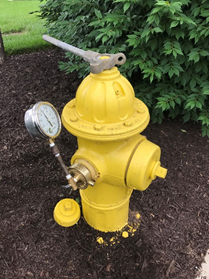Hydrant Flow Testing

The undefined term Hydrant flow testing is often used to describe a test conducted to determine hydrant flow performance. The reality is a flow test is used to determine the available water supply in the water main. The addition of the word hydrant does not change that test, nor does it provide specific hydrant performance data. This term creates confusion when the word hydrant is randomly added. It indicates that the flow test is being utilized to evaluate individual hydrant performance.
This disconnect often leads to confusion when Authorities Having Jurisdiction (AHJ) request an annual or five-year hydrant flow test, to verify adequate individual hydrant performance.
So, what is a flow test and what are the specific requirements for the testing of hydrants?
Flow Test
 NFPA 24: Standard for the Installation of Private Fire Service Mains and Their Appurtenances defines a flow test as a measurement of water from one hydrant and the static and residual pressures from an adjacent hydrant for the purpose of determining water supply. While hydrants are used in the determination of water supply, the test does not provide the actual hydrant flow capabilities.
NFPA 24: Standard for the Installation of Private Fire Service Mains and Their Appurtenances defines a flow test as a measurement of water from one hydrant and the static and residual pressures from an adjacent hydrant for the purpose of determining water supply. While hydrants are used in the determination of water supply, the test does not provide the actual hydrant flow capabilities.
Requirements for Hydrant Flow Tests
NFPA 1 Fire Code: requires all private water systems to be tested and maintained in accordance with NFPA 25, while public water supplies are required to meet the requirements set forth by ANSI/AWWA, Standard for Distribution Systems Operation and Management.
NFPA 1 also provides the requirements for fire flow for buildings and hydrant spacing/locations in Chapter 18. These requirements on based on water supply evaluated by a flow test. This again provides minimums for water supply but does not have a specific requirement for hydrant flow.
Hydrant Flow Testing and Water Supply
NFPA 25: Standard for the Inspection, Testing and Maintenance of Water-Based Fire Protections Systems provides guidance in Chapter 7- Private Fire Service Mains, on the requirements for annual hydrant inspections, testing and maintenance. Table 7.1.1.2 directs the user of the standard to the annual testing, requiring a hydrant flow, found in Section 7.3.2. This section requires hydrants to be fully tested to ensure proper hydrant operation and requires them to be opened fully and flowed for greater than one minute. This is simply flowing water from the hydrant to verify its operation and does not require an actual determination of the hydrant flow capacity.
The standard also provides guidance for the five-year underground and exposed pipe flow test used in determining water supply. NFPA 25 defines a water supply as a source of water that provides the flow and pressure required by the water-based fire protection systems.
NFPA 291 Recommendations for Hydrant Flow Tests
NFPA 291: Recommended Practice for Fire Flow Testing and Marking of Hydrants, has addressed this concern in the upcoming 2022 edition. The technical committee voted unanimously to clarify two separate and distinct flow tests.
- Layout of Test and Procedure to Determine the Available Water Supply in a Water Main
- Layout of Testing and Procedure to Evaluate the Available Flow Through a Fire Hydrant
This new procedure to evaluate the available flow through a fire hydrant will bring clarity to how the test is conducted and creates a new flow test procedure. It will simplify the flow test using only one hydrant and focus the test on identifying individual hydrant performance. Unfortunately, NFPA 291 being a recommended practice, does not create any requirements, nor does it make any recommendation on frequencies for performing this flow test through a fire hydrant.
Benefits of an NFSA Membership
Whether it’s hydrant flow testing or winterization, the NFSA is always on the cutting edge of ITM topics for fire protection. NFSA staff work closely in the codes and standards development process through NFPA and the International Code Council touting the benefits of fire sprinklers in the built environment. Our team of experts stays on the forefront of fire protection issues. For more information on NFSA’s mission to protect lives and property through the widespread acceptance of the fire sprinkler concept, to learn more about the benefits of NFSA membership, or to join our association, please visit our membership page to learn more.
